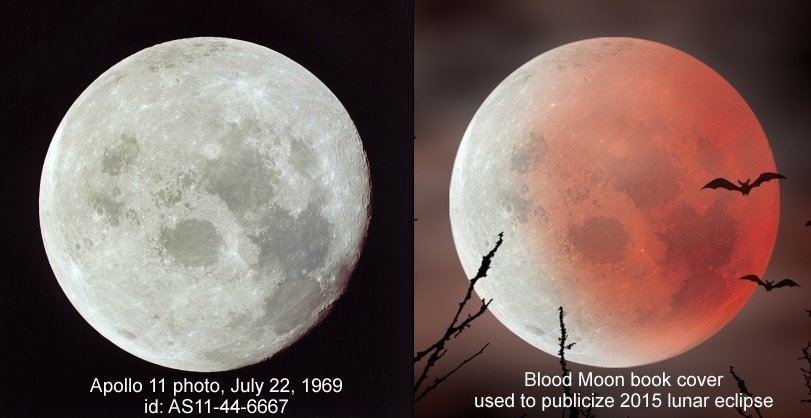
NavList:
A Community Devoted to the Preservation and Practice of Celestial Navigation and Other Methods of Traditional Wayfinding
From: Frank Reed
Date: 2015 Sep 25, 11:14 -0700
Luc, you wrote:
"The branch overlapping the moon on the left of the picture points right at the Mare Marginis, which isn't called that for no reason. It's supposed to be only just visible at the very edge of the limb. [...]
Was that what you were thinking?"
Yes, exactly. Below you'll see a comparison between an Apollo 11 photo and the artwork that was used to make the goofy "blood moon" poster (turns out it was taken from the cover of a vampire romance called "Blood Moon" --hence the bats).

Now borrowing from a NavList post that I made nine years ago regarding yet another Moon image:
The photograph shows a large portion of the Moon that is never visible from Earth. The photographer was directly above a point just south of Mare Crisium --the "eye" that we normally see from Earth as a small oval very close to the Moon's limb. Any of the Apollo spacecraft that travelled to lunar distances (Apollos 8 and 10-17) would have seen something similar as they departed the Moon, but the most likely image is AS11-44-6667 taken 46 years ago by the crew of Apollo 11 on July 22, 1969 around 0700 GMT. The "Blood Moon" graphic is an almost perfect match. If you do an Internet search on the image ID, you can find many versions. There is also a small possibility that an image from Apollo 16 was used instead, but it's not as good a match. This is an actual single photograph taken with a Hasselblad camera with a 70mm lens. I think it's a little amazing that an image of the Moon showing it in an orientation that's absolutely impossible to see from the surface of the Earth has been used over and over again as a representation of the Full Moon. We earthlings have seen the same mottled features on the face of the Moon since the beginning of history, but somehow, someone grabbed a view from space that can never be seen from here on terra firma. The Moon's the Moon, I guess!
We can get a line of position from the image. The exact center of the Moon's visible disk, taken from the original image, is located just south of Mare Crisium at 6 North, 59 East. These are the coordinates in the usual lunar system where the visible center as seen from Earth (after librations) is 0, 0. So we can draw a line from the Moon's center through that point 6N, 59E on the surface and extend it for some tens of thousands of miles into space. Naturally it goes nowhere near the Earth. It points about 60 degrees away from the Earth in the direction of the trailing Lagrangian point. The photographer and his companions --Armstrong, Aldrin, and Collins-- must have been situated somewhere along that line of position. If we had a scale for the image, we could measure the Moon's semidiameter and turn it into a distance along that line, fixing the position in space. In the absence of scale information, we have a statement from one NASA image caption that the spacecraft was 10,000 nautical miles from the Moon at this time. That's consistent with the image and the approximate time, but it sounds like a rough estimate to me.
Finally, even if the Moon were in the middle of a lunar eclipse when photographed from that same location, thousands of miles above the Moon's trailing side, it could not appear like this. The illumination would end just past Mare Crisium. In other words, as seen from this vantage point during a lunar eclipse, the Moon would be gibbous, a little more than half full.
Incidentally, this is the same Moon photo that appeared briefly in the first Lord of the Rings movie, which I recently (jokingly) claimed proves that Middle Earth is located in deep space near the Moon. :)
Frank Reed
ReedNavigation.com
Dark Side of the Moon






